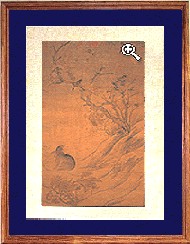
Tsui Po (fl. latter half of 11th c.), Sung Dynasty
(Original is Hanging scroll, ink and colors on silk, 76" x 40")
 |
 |
 |
 |
ˇ@
Tsˇ¦ui Po, a native of Anhwei province, excelled at painting Buddhist and Taoist subjects, figures, landscapes, flowers, and animals. He was especially noted for his works in the genre of birds-and-flowers.
This painting depicts two magpies crying out at a solitary hare. The magpie, relative of the crow, is known for its ingenuity, gregarious nature, and tenacious protection of its territory from intruders. Here, a magpie is shown in the upper right corner about to land on a branch to assist the other one, which is perched there bending down and spreading its wings in a display against the intrusive hare. The hare, however, seems to realize that the magpies do not pose much of a threat, so it doesnˇ¦t seem very frightened. In fact, it almost seems to stare at them calmly with an expression of ˇ§I canˇ¦t even pass through?ˇ¨
Drawing an imaginary line from the upper magpie, through the tree, and down to the foreground, it would form of an ˇ§S,ˇ¨ which not only integrates the composition but also creates balance and flow. The artist Tsˇ¦ui Po was also keen on highlighting the psychological tension of the scene by representing a strong wind that arches back the trees, bamboo, and grasses, thereby adding further energy and drama. This ˇ§slice of natureˇ¨ is not something easily imagined in a studio or at home. Rather, the artist must have had years of artistic training and experience in the wilds in order to capture this naturalistic scene. Tsˇ¦ui Po, with his great artistic skill, has taken the essence of this event and translated it onto silk. Thus, through a combination of his skill with brush and ink as well as his close observation, a masterpiece in fine-line paintings such as this is slowly produced. On the vertical trunk to the right is Tsˇ¦ui Poˇ¦s signature along with a date equivalent to 1061 AD.
